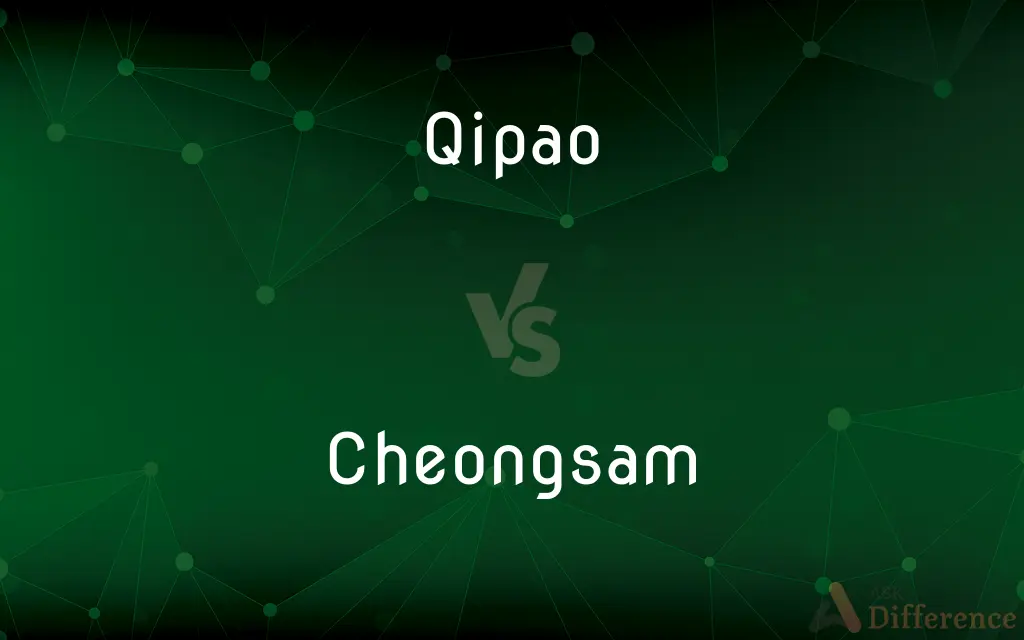Qipao vs. Cheongsam — What's the Difference?
Edited by Tayyaba Rehman — By Maham Liaqat — Updated on March 20, 2024
Qipao and Cheongsam refer to the same traditional Chinese dress, known for its elegance and fitted silhouette.

Difference Between Qipao and Cheongsam
Table of Contents
ADVERTISEMENT
Key Differences
The terms Qipao and Cheongsam are often used interchangeably to describe a traditional Chinese dress that originated in the 17th century during the Qing Dynasty. This garment is characterized by its fitted silhouette, high neck, and side slits.
While "Qipao" is the term more commonly used in Mandarin Chinese, "Cheongsam" comes from the Cantonese pronunciation and is more frequently used in Hong Kong and international contexts. Despite the different names, they refer to the same garment and its variations.
Historically, the Qipao/Cheongsam was a loose-fitting dress that covered most of the woman's body, providing modesty and comfort. Over time, especially in the 20th century, the design evolved into a more form-fitting and shorter version, reflecting changing fashion sensibilities and social changes.
The modern version of the Qipao/Cheongsam is recognized for its ability to highlight the feminine form while maintaining a sense of modesty and elegance. It often features intricate fabric designs, such as embroidered silk, and may be adorned with traditional Chinese motifs.
Both Qipao and Cheongsam are worn on formal occasions, such as weddings and banquets, and are considered symbols of Chinese cultural heritage. The dress has also gained international recognition and is appreciated for its aesthetic appeal and craftsmanship.
ADVERTISEMENT
Comparison Chart
Terminology
Mandarin Chinese term
Cantonese term, widely used in Hong Kong and internationally
Origin
Qing Dynasty, 17th century
Same origin as Qipao
Design Evolution
From loose-fitting to form-fitting
Same evolutionary path as Qipao
Modern Appearance
Fitted silhouette, high neck, side slits
Identical to Qipao
Cultural Significance
Symbol of Chinese cultural heritage
Same cultural significance as Qipao
Compare with Definitions
Qipao
Known as Qipao in Mandarin-speaking regions.
She wore a stunning silk qipao to the event.
Cheongsam
Shares the same origins and history as the qipao.
The cheongsam, with its intricate designs, captivated everyone at the party.
Qipao
Combines elegance with a sense of modesty.
The qipao she chose exuded elegance while maintaining modesty.
Cheongsam
Often used in Hong Kong and by international communities.
Her cheongsam was the highlight of the international fashion show.
Qipao
Originated in the 17th century Qing Dynasty.
The qipao has evolved significantly from its traditional design.
Cheongsam
Features elaborate fabrics and motifs.
The silk cheongsam was adorned with exquisite traditional embroidery.
Qipao
Represents Chinese cultural heritage.
The qipao is more than a dress; it's a symbol of rich cultural history.
Cheongsam
Known for its elegance and distinctive style.
The cheongsam is celebrated for its unique elegance and aesthetic.
Qipao
Modern qipaos are known for their form-fitting silhouette.
Contemporary qipaos often feature a more form-fitting design, accentuating the figure.
Cheongsam
A key piece of Chinese cultural identity.
Wearing a cheongsam is a beautiful way to honor one's heritage.
Qipao
See cheongsam.
Cheongsam
The cheongsam (UK: , US: ), also known as the qipao (), is a type of body-hugging dress of Manchu origin. It is a high-necked, closefitting dress with the skirt slit partway up the side.
Qipao
A traditional one-piece dress worn by Chinese women.
Cheongsam
A formfitting dress with a high collar and usually long, slit skirt, traditionally worn by Chinese women. Also called qipao.
Cheongsam
A tight-fitting Chinese formal woman's dress, usually brightly coloured, patterned and/or embroidered, with a split at the thigh.
Cheongsam
(Hong Kong) A plain coloured, tight-fitting dress with a short split at the thigh, worn as a school uniform by schoolgirls.
Cheongsam
A long formal dress-like garment or robe worn by Asian men.
Common Curiosities
How has the design of the Qipao/Cheongsam changed over time?
The design evolved from a loose-fitting style to a more form-fitting silhouette, reflecting changes in fashion and society.
Why are there two names for the same dress?
The two names arise from different Chinese dialects: Qipao from Mandarin and Cheongsam from Cantonese.
Is the Qipao/Cheongsam worn outside of China?
Yes, the Qipao/Cheongsam is worn and recognized internationally, often at cultural events or in fashion contexts.
Are Qipao and Cheongsam the same?
Yes, Qipao and Cheongsam refer to the same traditional Chinese dress, with differences mainly in regional terminology.
Can the Qipao/Cheongsam be worn casually?
While traditionally worn on formal occasions, modern adaptations can be styled for more casual settings.
What are common features of a Qipao/Cheongsam?
Common features include a high neck, a form-fitting silhouette, side slits, and often intricate designs or embroidery.
Are there modern variations of the Qipao/Cheongsam?
Yes, designers have created modern variations that may include different lengths, fabrics, and adaptations for various occasions.
How do you choose the right Qipao/Cheongsam?
Consider the occasion, fit, fabric, and personal style to choose a Qipao/Cheongsam that complements and feels comfortable.
Is the Qipao/Cheongsam considered formal wear?
Yes, it is traditionally considered formal wear, though contemporary styles can vary in formality.
How is a Qipao/Cheongsam traditionally accessorized?
Traditionally, it may be paired with simple, elegant jewelry and shoes that complement the dress's design.
How is the Qipao/Cheongsam perceived in fashion today?
It is viewed as a blend of traditional elegance and modern fashion, often celebrated for its aesthetic appeal and cultural significance.
What occasions are suitable for wearing a Qipao/Cheongsam?
It is suitable for weddings, cultural events, formal gatherings, and, in modern adaptations, even semi-casual events.
What is the cultural significance of the Qipao/Cheongsam?
It is a symbol of Chinese cultural heritage, representing the nation's history, aesthetics, and evolving fashion sensibilities.
Can men wear a Qipao/Cheongsam?
The traditional Qipao/Cheongsam is designed for women, but there are male garments with similar aesthetic influences.
What materials are typically used in making a Qipao/Cheongsam?
Silk is traditional, but modern versions may use a variety of fabrics, including cotton, polyester, and blends for different looks and comfort levels.
Share Your Discovery

Previous Comparison
Salmon vs. Tuna
Next Comparison
Us vs. OurAuthor Spotlight
Written by
Maham LiaqatEdited by
Tayyaba RehmanTayyaba Rehman is a distinguished writer, currently serving as a primary contributor to askdifference.com. As a researcher in semantics and etymology, Tayyaba's passion for the complexity of languages and their distinctions has found a perfect home on the platform. Tayyaba delves into the intricacies of language, distinguishing between commonly confused words and phrases, thereby providing clarity for readers worldwide.
















































